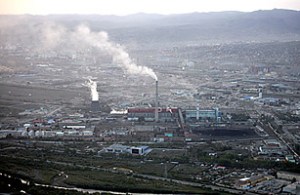
Ulan Bator, Mongolia—the second-most polluted city in the world. Credit: Doug Kanter / Bloomberg / Getty Images
Environmentalists here in the U.S. are not happy with President Obama, in part because he pulled back on a promise to tighten ground-level ozone and smog standards for air pollution. But American greens should remember: much of the rest of the world has it far, far, far worse.
That’s one takeaway from a new report by the World Health Organization that looked at urban air pollution around the world. The most polluted cities tend to be found in developing countries. No surprise there—poorer countries tend to have dirtier cars, factories and power plants, and rarely have or enforce the kind of environmental regulations that have—over the course of decades—become common in the developed world. But what’s interesting is that the urban areas with the worst air aren’t the sort of Dickensian megacities one usually hears about: Beijing, Chongqing, Bangkok, Mexico City. The losers are smaller cities, many of them in Iran or South Asia, and none of them economic dynamos.
(PHOTOS: The Terrible Beauty of Industrial Pollution)
Here’s the top—or rather bottom—10:
1. Ahwaz, Iran
2. Ulan Bator, Mongolia
3. Sanadaj, Iran
4. Ludhiana, India
5. Quetta, Pakistan
6. Kermanshah, Iran
7. Peshawar, Pakistan
8. Gaberone, Botswana
9. Yasouj, Iran
10. Kanpor, India
What do these cities all have in common, aside from the fact they’re not likely to show up on a travel agent’s ? They’re all very poor For the most part, they’re fairly poor—though the presence of a city from the African nation of Botswana on the list, where the per-capita income is over $8,000, shows that even middle-income countries can suffer from grievous air pollution. (Note: Thanks to my former colleague Simon Robinson for pointing out my mistake on Botswana.) Residents often burn heavy, polluting fuel for heat and energy—including firewood or even dung, which can produce heavy, thick smoke. Add in old, diesel-powered cars that belch black carbon and growing population density in urban slums—plus weather conditions like Ulan Bator’s extreme cold, which worsens air pollution—and you have an ugly mess.
(PHOTOS: Top 10 Green Buildings of 2011)
But it’s not just about looks. Air pollution—both indoor and outdoor—is a major health hazard. The WHO estimates that over 2 million people a year die prematurely from bad air—most of them in poor countries and cities. That’s greater than the annual death toll from HIV/AIDS. And the more researchers learn about the effect of air pollution on the human body, the worse it seems to be. Pollution particles less than 10 microns in diameter—what the WHO calls PM10—are particularly nasty, penetrating deep into the lungs and the bloodstream, where they can help trigger heart attacks and other cardiovascular disease. In animal models, such pollution has even led to brain damage.
(TIME: Global Warming Threatens the Heart of Antarctica)
The WHO air quality standards recommend 20 micrograms per cu m of PM10 or less. Just to give you an idea of how polluted the world’s most polluted cities are, Ahvaz in Iran has 372 micrograms per cu m. Air pollution is a global health catastrophe, but because it’s happening invisibly—and mostly in the developing world—it’s one that doesn’t get anywhere near the attention it deserves.
Worst of all, there’s little that residents of heavily polluted cities can do to protect themselves—after all, everyone needs to breathe. Your best bet might be to simply leave—in which case, let me recommend the beautiful Yukon city of Whitehorse in Canada, which has just 3 micrograms per cu. m of PM10, making it the cleanest city in the WHO rankings. Just keep in mind—winter temperatures can drop to -7 F (-22 C). But the air is amazing.
PHOTOS: This Fragile Earth
Bryan Walsh is a senior writer at TIME. Find him on Twitter at @bryanrwalsh. You can also continue the discussion on TIME’s Facebook page and on Twitter at @TIME


